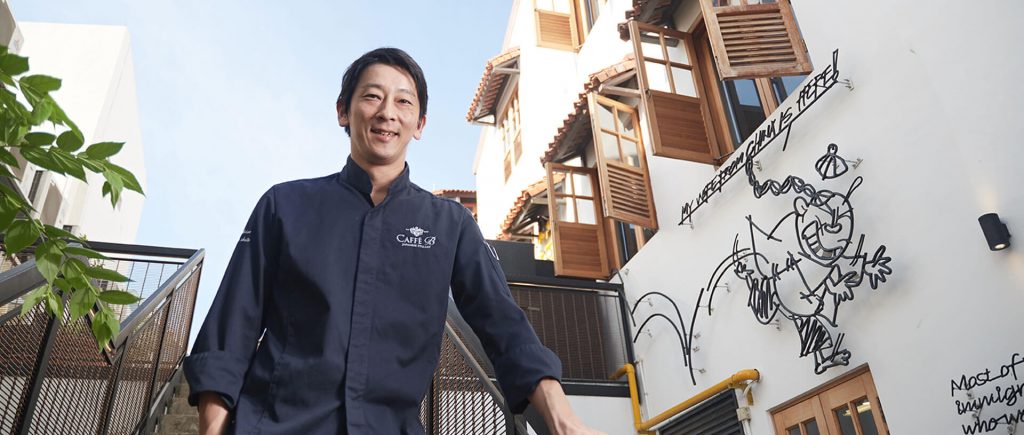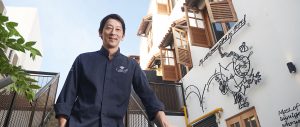Every time Masanao Saito visits Maxwell Food Market for a meal, he flashes his signature grin and the hawkers immediately know what to prepare.
At his go-to Chinese economical rice food stall, stall attendants begin preparing his favourite meal combo as soon as they see him standing in queue.
They know the drill — a bowl of steamed rice, stir-fried bitter gourd, tofu stew, and a hearty serving of chicken curry served with a dash of kindness.
“I’ve always believed that food has the ability to build bridges and this is true in a place like Singapore. There’re so many different cultures and cuisines so there’s always an opportunity to meet new people and try new cuisines,” says the Chief Adviser at Caffe B, a Japanese-Italian fusion restaurant located at Club Street.
A native of Saitama prefecture located in the Greater Tokyo Area, Masanao’s experience in the kitchen started in a local Izakaya (a casual Japanese pub) at the age of 16. He spent the next few years divining an infusion of colours and flavours as he worked his way across various restaurants, honing his culinary skills alongside the best of the Japanese food scene.
In 2014, after almost four years cooking at the Embassy of Japan in Sweden, he decided it was time for a change. He moved to Singapore to helm Hanashizuku — an Izakaya-style restaurant at Cuppage Plaza.
The first thing that struck him about the local culinary scene was its unbelievable diversity — something he attributes to the cosmopolitan vibe of the country.
“There so many opportunities and possibilities for the culinary scene here because a lot of people come here from different countries, bringing along their food heritage and history with them,” he says.
In 2016, he took on the role of culinary director at 999.99, a Japanese-European restaurant. Two years later, he transitioned to the role of Chief Adviser at Caffe B, a Japanese-Italian fusion restaurant at Club Street.
Masanao’s earliest memories of Singaporean food were when he first stepped foot into the country. He was invited by a friend to dine at Old Tiong Bahru Bak Kut Teh located at Seng Poh Road.
It was love at first taste for Masanao, who remains a fan of its succulent pork meat, chewy Youtiao (fried breadstick) and dollops of porridge. In fact, he still goes back once or twice each month.
To widen his knowledge of the flavours available in Singapore, Masanao approached local chefs and stall owners to learn their cooking techniques. He even applied for formal training at a local culinary academy.
It was hard labour and long hours but being able to master traditional cooking methods was the icing on the cake for the culinary enthusiast.
“I made Singaporean friends while learning how to cook one of the country’s most famous dishes. How could I complain? It was a good experience and opportunity to learn about the country,” he says.
As someone who believes in the power of food to unite communities, Masanao began inviting local colleagues and friends over to his place for Temaki Sushi sessions where people were able to pick, choose and roll their own sushi.
By allowing people a hands-on approach towards learning a new cuisine, he was able to open up about his experiences growing up in Japan, whilst also learning about life in Singapore.
Having witnessed the growth of Singapore’s culinary scene over the years, Masanao believes that Singapore can become the Michelin capital of the world.
Apart from highly skilled chefs and a dynamic culinary scene, what sets Singapore apart is its ability to bring together people from different parts of the world together — a feat that most countries find hard to achieve, he explains.
“The most important thing about making good food is being open to new ideas and techniques. It is a constant learning process and Singapore is the perfect place for any restaurant or chef hoping to make a mark on the world.”

OxPay Appointed as Digital Payment
Provider for Q & M Dental’s Singapore
Clinics
SINGAPORE, April 18, 2022 – OxPay Financial Limited (SGX: TVV) (“OxPay” or the “Company”, and together with its subsidiaries, the “Group”) is pleased to announce










